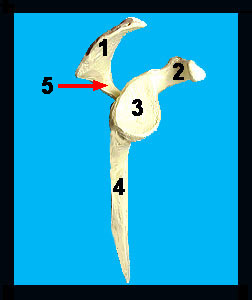|
|
||||||||||||||||||||||||||||||||||||||||||||||||||||||||||||||||||||||||||||||||||||||||||||||||||||||||||||||||||||||||||||||||||||||||||||||||||
|
This image shows a lateral view of the right scapula. The scapula is a thin triangular shaped bone that lies on the dorsal surface of the rib cage. The most prominent features of the scapula are the processes for the attachment of muscles. The most prominent process on the posterior surface of the scapula is the spine which terminates in the acromion process. The edge above the spine is the superior border, which has a distinct suprascapular notch through which nerves pass. Note that the superior border terminates in the coracoid process. This process serves as an attachment site for the biceps muscle. The lateral border begins as the shallow depression called the glenoid cavity. The glenoid cavity is the site of articulation with the head of the humerus. This joint, the shoulder joint, is classified as a ball and socket joint. The medial border runs parallel to the vertebral column. On the posterior surface there are two prominent fossae. Superior to the spine is the supraspinous fossa and inferior to the spine is the infraspinous fossa. The major depression on the anterior surface is the subscapular fossa. |
|
